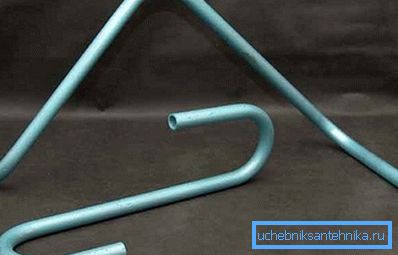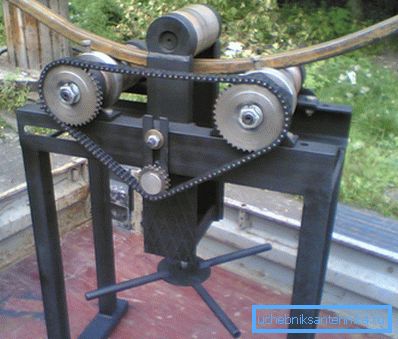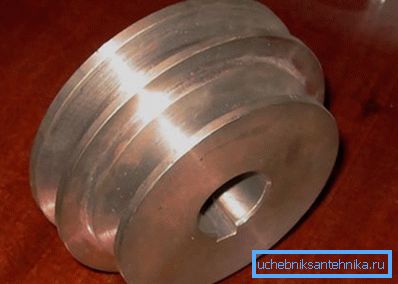The pipe bender - features of the tool and its own
Often, when performing various works in the country or in the garage, there is a need to bend the pipe around a certain circle to obtain the correct geometric shape. To achieve such a result is possible only with the help of a special tool, however, it will be expensive to purchase a device for several operations. To help solve this problem, in this article we will look at how to make a pipe bender yourself.

Features of the equipment
Purpose of the device
In the manufacture of various metal structures, such as gazebos, greenhouses, fences, garden furniture, etc., profile tubes are very popular because they are durable, durable and affordable material. However, the manufacturing technology of some of these structures requires the pipes to be bent at a certain radius or at a certain angle. In addition, bending may be required during pipeline installation.
It is impossible to carry out such an operation with your hands, but the pipe bender will allow you to cope with the task without much difficulty. With it, you can bend the pipes at an angle from 0 to 180 degrees. Most often in such devices used electromechanical or hydraulic drive.

I must say that this tool is quite versatile, as it allows you to bend various types of pipes:
- Boiler rooms;
- Gas;
- Plumbing;
- Profile, etc.
As for the material, they can be made from:
- Become;
- Copper;
- Aluminum;
- Metal-plastic.

The only pipe diameter should be no more than two inches. As a result, the scope of this tool is very extensive.
In particular, it is used:
- In boiler rooms;
- Gas stations;
- When installing heating and plumbing systems, etc.

Types of fixtures
Before proceeding to the manufacture of the tool, consider what types of pipe benders exist:
| Manual | Designed to perform such operations as bending of rings and arcs of different radii. Its weight is usually small, which allows you to transport the tool to the place of work with metal structures. The price of such a product is not relatively high. The tool can work with profiled pipes with a cross-section of up to 4x4 cm and round, with a diameter of up to 3x3 cm. |
| Manual hydraulic | The drive of this tool has a hydraulic installation that enhances the force of the operator. As a result, large diameter pipes can be bent. The fixture is recommended for installation and dismantling of gas pipelines and water pipes. |
| Electric | Used to work with pipes on a production scale. They allow to bend profiled products with a cross section up to 80-40 mm. The diameter limit of round pipes is 30 mm. A feature of these products is high performance and the availability of additional functions, such as control using buttons or foot pedals, rotating in both directions, etc. |

In addition, all existing tools differ in terms of operating conditions for:
- Manual - used for home use or directly at the installation site of pipes.
- Stationary - are machines that are used in enterprises where pipe bending is part of the process.
Tip! If you need to get a large radius of the pipe, for example, for the manufacture of an arched greenhouse, knock down boards and cut a semicircle of the desired radius. After that, you can go around the pipe with your own hands around this fixture.

Tool making
It is quite simple to perform a simple bending device.
The only thing you will need are some plumbing skills, as well as some tool:
- Welding machine;
- Bulgarian;
- Tape measure and pencil.
As for materials, you will need several sheets of metal with a thickness of 3 and 10 mm, as well as several steel bars.
So, the instruction looks like this:
- The first step is to prepare the pulleys. To make the device universal, i.e. for pipes of different diameters, two triple pulleys should be used - a pair for half-inch pipes, a pair for inch pipes and a pair for three-quarter pipes. Immediately I must say that to buy such pulleys will not work, so they need to be ordered in the workshop.
On each side of the wheel, there should be a recess in it corresponding to half the diameter of the pipe. The stationary roller should have a minimum diameter, since it will depend on the minimum bending radius.

- Next you need to make a base of metal with a thickness of about 10 mm, which is a square plate with holes at the corners, for attaching to the table.
- Then in the center of the plate it is necessary to install by means of welding a pin, the diameter of which should correspond to the inner diameter of the small triple pulley.
- After the bed will be ready, it is necessary to execute the turning mechanism. To do this, first of all you need to boil the U-shaped part of two metal plates. The height of the legs of the part must correspond to the diameter of the small and large pulley, so that in this distance a large movable pulley and half of the stationary will completely fit.
- A handle about 25 cm long is welded to the top of the part. A tube acting as a lever will later be put on this handle.
- Next, a large pin is installed at the edge of the part, which is fixed with cotter pins. A small pulley is put on the base pin with the entire structure.
- Now it remains only to perform the emphasis - for this, one more pin is welded and a pulley is put on it.
The process of manufacturing parts completed. Now it remains only to fix the tool on the table, and you can begin to bend the pipes.
Tip! To prevent the tube from flattening during the bending, it should be filled with sand and the ends should be chopped with choopy.
Conclusion
Each home master can make a manual pipe bender on their own. Of course, this operation will take some time, however, this tool is really useful, and, certainly, it will come in handy on the farm more than once.
From the video in this article, you can get more information on this topic.